over drive NISSAN ROGUE SPORT 2022 Owners Manual
[x] Cancel search | Manufacturer: NISSAN, Model Year: 2022, Model line: ROGUE SPORT, Model: NISSAN ROGUE SPORT 2022Pages: 508, PDF Size: 2.43 MB
Page 2 of 508
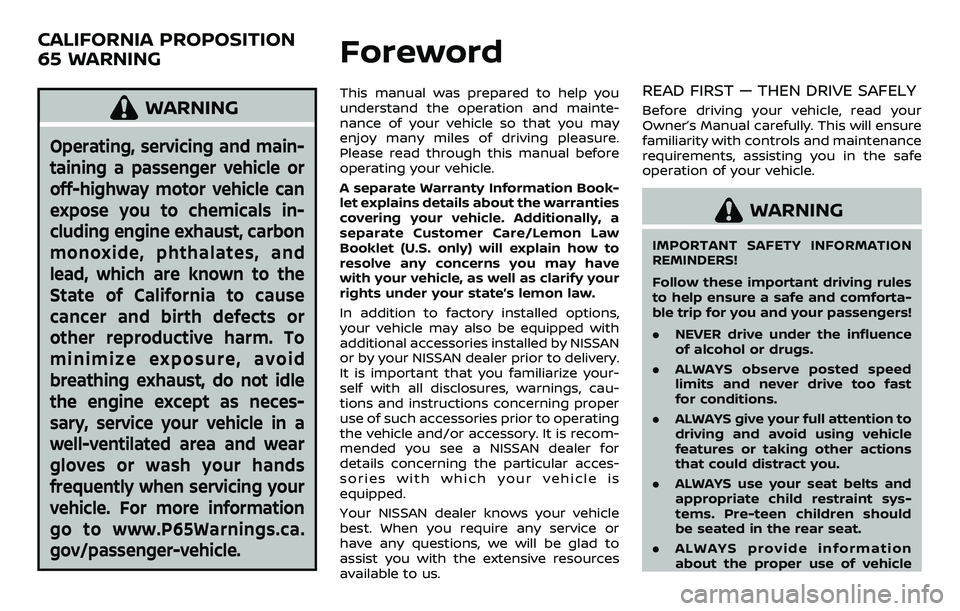
WARNING
Operating, servicing and main-
taining a passenger vehicle or
off-highway motor vehicle can
expose you to chemicals in-
cluding engine exhaust, carbon
monoxide, phthalates, and
lead, which are known to the
State of California to cause
cancer and birth defects or
other reproductive harm. To
minimize exposure, avoid
breathing exhaust, do not idle
the engine except as neces-
sary, service your vehicle in a
well-ventilated area and wear
gloves or wash your hands
frequently when servicing your
vehicle. For more information
go to www.P65Warnings.ca.
gov/passenger-vehicle.
This manual was prepared to help you
understand the operation and mainte-
nance of your vehicle so that you may
enjoy many miles of driving pleasure.
Please read through this manual before
operating your vehicle.
A separate Warranty Information Book-
let explains details about the warranties
covering your vehicle. Additionally, a
separate Customer Care/Lemon Law
Booklet (U.S. only) will explain how to
resolve any concerns you may have
with your vehicle, as well as clarify your
rights under your state’s lemon law.
In addition to factory installed options,
your vehicle may also be equipped with
additional accessories installed by NISSAN
or by your NISSAN dealer prior to delivery.
It is important that you familiarize your-
self with all disclosures, warnings, cau-
tions and instructions concerning proper
use of such accessories prior to operating
the vehicle and/or accessory. It is recom-
mended you see a NISSAN dealer for
details concerning the particular acces-
sories with which your vehicle is
equipped.
Your NISSAN dealer knows your vehicle
best. When you require any service or
have any questions, we will be glad to
assist you with the extensive resources
available to us.READ FIRST — THEN DRIVE SAFELY
Before driving your vehicle, read your
Owner’s Manual carefully. This will ensure
familiarity with controls and maintenance
requirements, assisting you in the safe
operation of your vehicle.
WARNING
IMPORTANT SAFETY INFORMATION
REMINDERS!
Follow these important driving rules
to help ensure a safe and comforta-
ble trip for you and your passengers!
.NEVER drive under the influence
of alcohol or drugs.
. ALWAYS observe posted speed
limits and never drive too fast
for conditions.
. ALWAYS give your full attention to
driving and avoid using vehicle
features or taking other actions
that could distract you.
. ALWAYS use your seat belts and
appropriate child restraint sys-
tems. Pre-teen children should
be seated in the rear seat.
. ALWAYS provide information
about the proper use of vehicle
CALIFORNIA PROPOSITION
65 WARNING
Foreword
Page 10 of 508
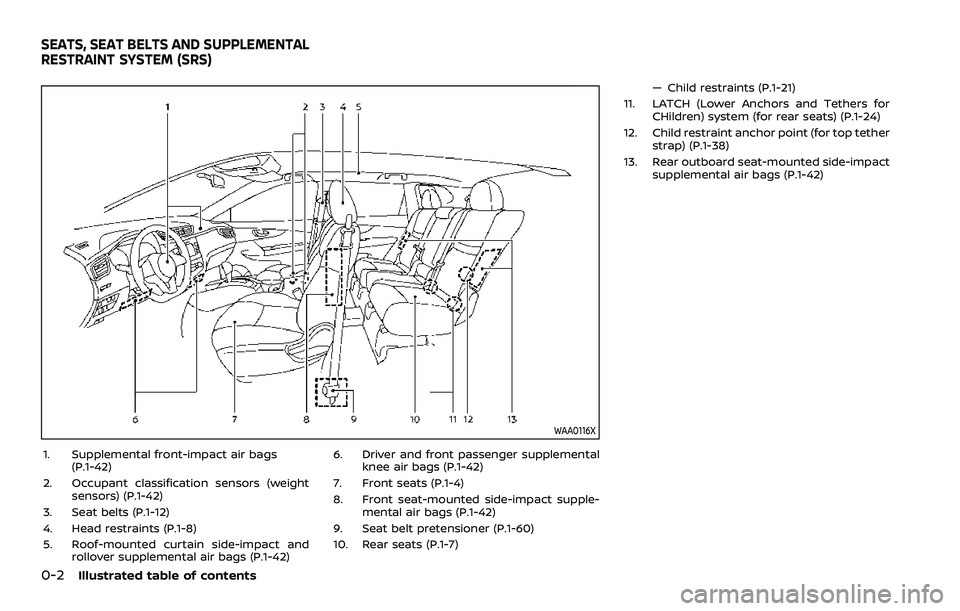
0-2Illustrated table of contents
WAA0116X
1. Supplemental front-impact air bags(P.1-42)
2. Occupant classification sensors (weight sensors) (P.1-42)
3. Seat belts (P.1-12)
4. Head restraints (P.1-8)
5. Roof-mounted curtain side-impact and rollover supplemental air bags (P.1-42) 6. Driver and front passenger supplemental
knee air bags (P.1-42)
7. Front seats (P.1-4)
8. Front seat-mounted side-impact supple- mental air bags (P.1-42)
9. Seat belt pretensioner (P.1-60)
10. Rear seats (P.1-7) — Child restraints (P.1-21)
11. LATCH (Lower Anchors and Tethers for CHildren) system (for rear seats) (P.1-24)
12. Child restraint anchor point (for top tether strap) (P.1-38)
13. Rear outboard seat-mounted side-impact supplemental air bags (P.1-42)
SEATS, SEAT BELTS AND SUPPLEMENTAL
RESTRAINT SYSTEM (SRS)
Page 15 of 508
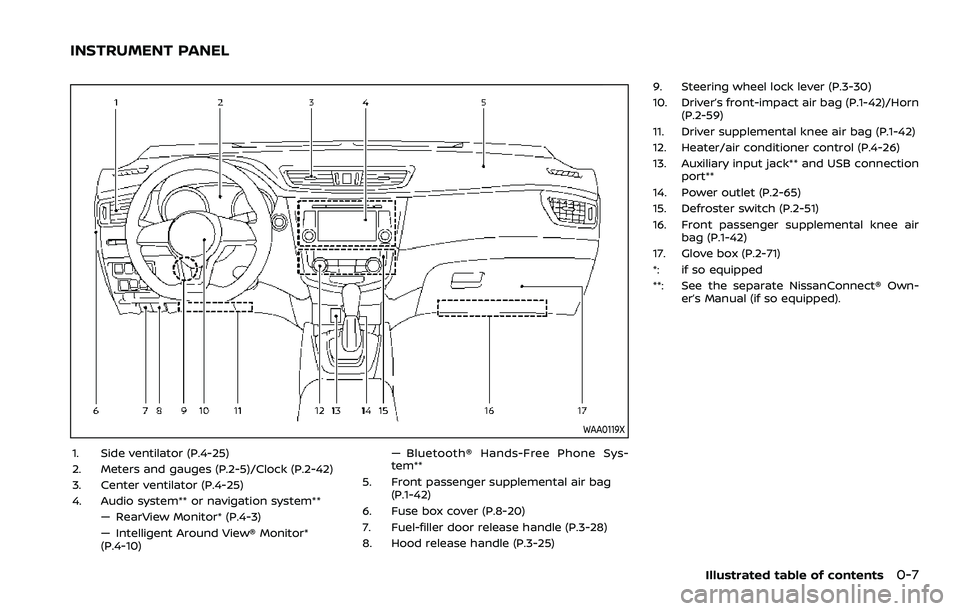
WAA0119X
1. Side ventilator (P.4-25)
2. Meters and gauges (P.2-5)/Clock (P.2-42)
3. Center ventilator (P.4-25)
4. Audio system** or navigation system**— RearView Monitor* (P.4-3)
— Intelligent Around View® Monitor*
(P.4-10) — Bluetooth® Hands-Free Phone Sys-
tem**
5. Front passenger supplemental air bag (P.1-42)
6. Fuse box cover (P.8-20)
7. Fuel-filler door release handle (P.3-28)
8. Hood release handle (P.3-25) 9. Steering wheel lock lever (P.3-30)
10. Driver’s front-impact air bag (P.1-42)/Horn
(P.2-59)
11. Driver supplemental knee air bag (P.1-42)
12. Heater/air conditioner control (P.4-26)
13. Auxiliary input jack** and USB connection port**
14. Power outlet (P.2-65)
15. Defroster switch (P.2-51)
16. Front passenger supplemental knee air bag (P.1-42)
17. Glove box (P.2-71)
*: if so equipped
**: See the separate NissanConnect® Own- er’s Manual (if so equipped).
Illustrated table of contents0-7
INSTRUMENT PANEL
Page 19 of 508
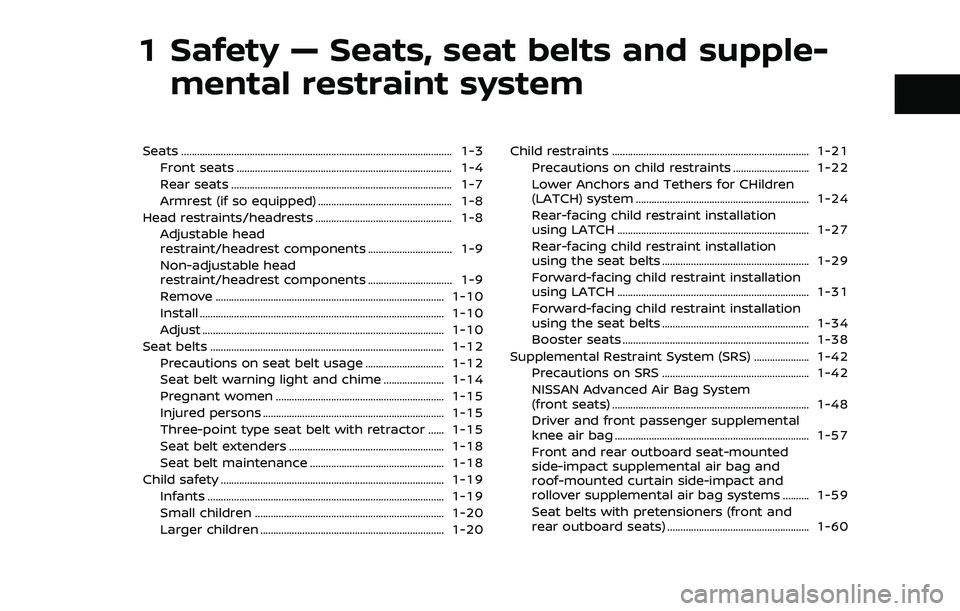
1 Safety — Seats, seat belts and supple-mental restraint system
Seats ........................................................................\
............................... 1-3
Front seats ........................................................................\
.......... 1-4
Rear seats ........................................................................\
............ 1-7
Armrest (if so equipped) ................................................... 1-8
Head restraints/headrests .................................................... 1-8 Adjustable head
restraint/headrest components ................................ 1-9
Non-adjustable head
restraint/headrest components ................................ 1-9
Remove ........................................................................\
............... 1-10
Install ........................................................................\
..................... 1-10
Adjust ........................................................................\
.................... 1-10
Seat belts ........................................................................\
................. 1-12
Precautions on seat belt usage .............................. 1-12
Seat belt warning light and chime ....................... 1-14
Pregnant women ................................................................ 1-15
Injured persons ..................................................................... 1-15
Three-point type seat belt with retractor ...... 1-15
Seat belt extenders ........................................................... 1-18
Seat belt maintenance ................................................... 1-18
Child safety ........................................................................\
............. 1-19 Infants ........................................................................\
.................. 1-19
Small children ........................................................................\
1-20
Larger children ...................................................................... 1-20 Child restraints ........................................................................\
... 1-21
Precautions on child restraints ............................. 1-22
Lower Anchors and Tethers for CHildren
(LATCH) system .................................................................. 1-24
Rear-facing child restraint installation
using LATCH ........................................................................\
. 1-27
Rear-facing child restraint installation
using the seat belts ........................................................ 1-29
Forward-facing child restraint installation
using LATCH ........................................................................\
. 1-31
Forward-facing child restraint installation
using the seat belts ........................................................ 1-34
Booster seats ....................................................................... 1-38
Supplemental Restraint System (SRS) ..................... 1-42 Precautions on SRS ........................................................ 1-42
NISSAN Advanced Air Bag System
(front seats) ........................................................................\
... 1-48
Driver and front passenger supplemental
knee air bag ........................................................................\
.. 1-57
Front and rear outboard seat-mounted
side-impact supplemental air bag and
roof-mounted curtain side-impact and
rollover supplemental air bag systems .......... 1-59
Seat belts with pretensioners (front and
rear outboard seats) ...................................................... 1-60
Page 31 of 508
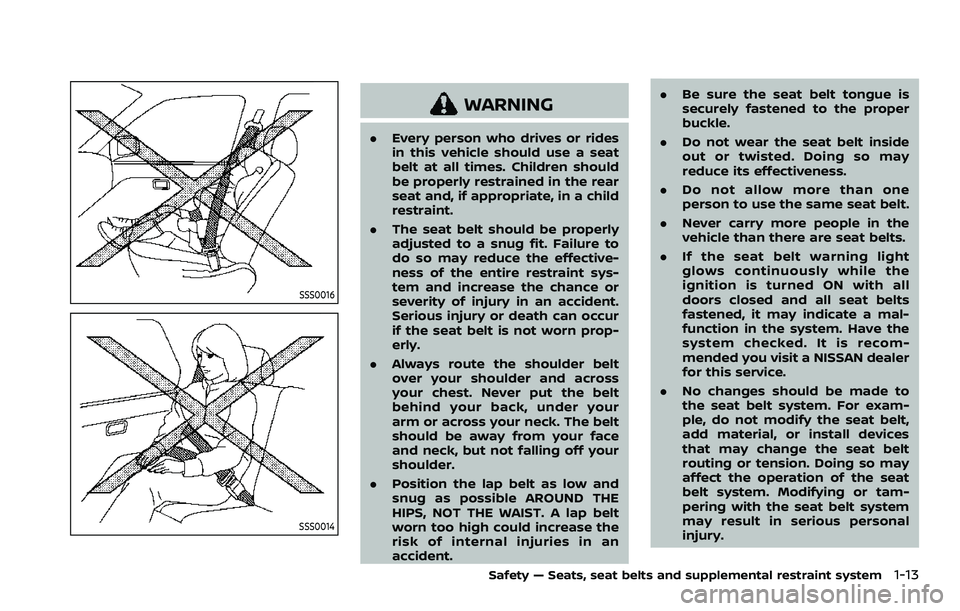
SSS0016
SSS0014
WARNING
.Every person who drives or rides
in this vehicle should use a seat
belt at all times. Children should
be properly restrained in the rear
seat and, if appropriate, in a child
restraint.
. The seat belt should be properly
adjusted to a snug fit. Failure to
do so may reduce the effective-
ness of the entire restraint sys-
tem and increase the chance or
severity of injury in an accident.
Serious injury or death can occur
if the seat belt is not worn prop-
erly.
. Always route the shoulder belt
over your shoulder and across
your chest. Never put the belt
behind your back, under your
arm or across your neck. The belt
should be away from your face
and neck, but not falling off your
shoulder.
. Position the lap belt as low and
snug as possible AROUND THE
HIPS, NOT THE WAIST. A lap belt
worn too high could increase the
risk of internal injuries in an
accident. .
Be sure the seat belt tongue is
securely fastened to the proper
buckle.
. Do not wear the seat belt inside
out or twisted. Doing so may
reduce its effectiveness.
. Do not allow more than one
person to use the same seat belt.
. Never carry more people in the
vehicle than there are seat belts.
. If the seat belt warning light
glows continuously while the
ignition is turned ON with all
doors closed and all seat belts
fastened, it may indicate a mal-
function in the system. Have the
system checked. It is recom-
mended you visit a NISSAN dealer
for this service.
. No changes should be made to
the seat belt system. For exam-
ple, do not modify the seat belt,
add material, or install devices
that may change the seat belt
routing or tension. Doing so may
affect the operation of the seat
belt system. Modifying or tam-
pering with the seat belt system
may result in serious personal
injury.
Safety — Seats, seat belts and supplemental restraint system1-13
Page 33 of 508
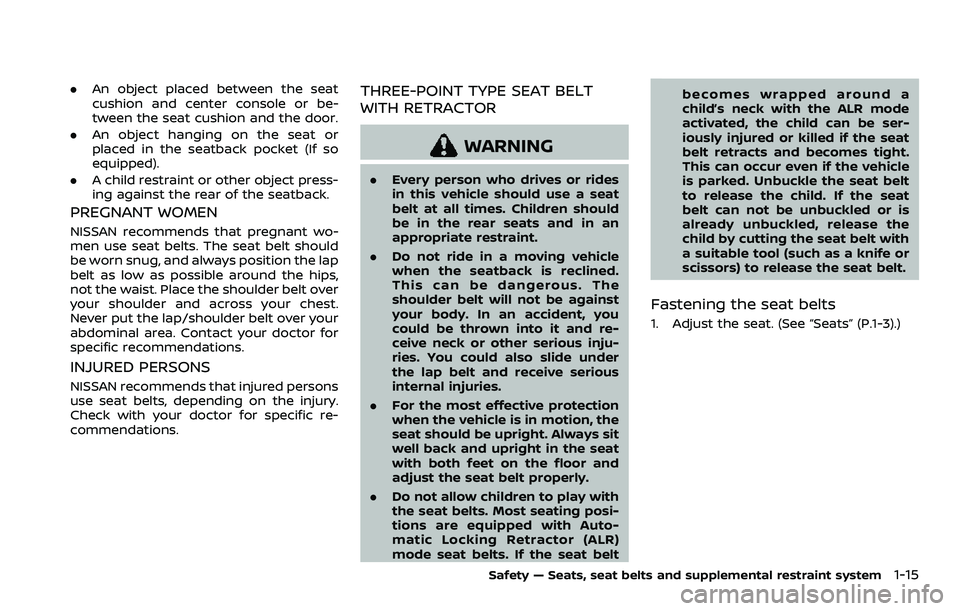
.An object placed between the seat
cushion and center console or be-
tween the seat cushion and the door.
. An object hanging on the seat or
placed in the seatback pocket (If so
equipped).
. A child restraint or other object press-
ing against the rear of the seatback.
PREGNANT WOMEN
NISSAN recommends that pregnant wo-
men use seat belts. The seat belt should
be worn snug, and always position the lap
belt as low as possible around the hips,
not the waist. Place the shoulder belt over
your shoulder and across your chest.
Never put the lap/shoulder belt over your
abdominal area. Contact your doctor for
specific recommendations.
INJURED PERSONS
NISSAN recommends that injured persons
use seat belts, depending on the injury.
Check with your doctor for specific re-
commendations.
THREE-POINT TYPE SEAT BELT
WITH RETRACTOR
WARNING
.Every person who drives or rides
in this vehicle should use a seat
belt at all times. Children should
be in the rear seats and in an
appropriate restraint.
. Do not ride in a moving vehicle
when the seatback is reclined.
This can be dangerous. The
shoulder belt will not be against
your body. In an accident, you
could be thrown into it and re-
ceive neck or other serious inju-
ries. You could also slide under
the lap belt and receive serious
internal injuries.
. For the most effective protection
when the vehicle is in motion, the
seat should be upright. Always sit
well back and upright in the seat
with both feet on the floor and
adjust the seat belt properly.
. Do not allow children to play with
the seat belts. Most seating posi-
tions are equipped with Auto-
matic Locking Retractor (ALR)
mode seat belts. If the seat belt becomes wrapped around a
child’s neck with the ALR mode
activated, the child can be ser-
iously injured or killed if the seat
belt retracts and becomes tight.
This can occur even if the vehicle
is parked. Unbuckle the seat belt
to release the child. If the seat
belt can not be unbuckled or is
already unbuckled, release the
child by cutting the seat belt with
a suitable tool (such as a knife or
scissors) to release the seat belt.
Fastening the seat belts
1. Adjust the seat. (See “Seats” (P.1-3).)
Safety — Seats, seat belts and supplemental restraint system1-15
Page 34 of 508
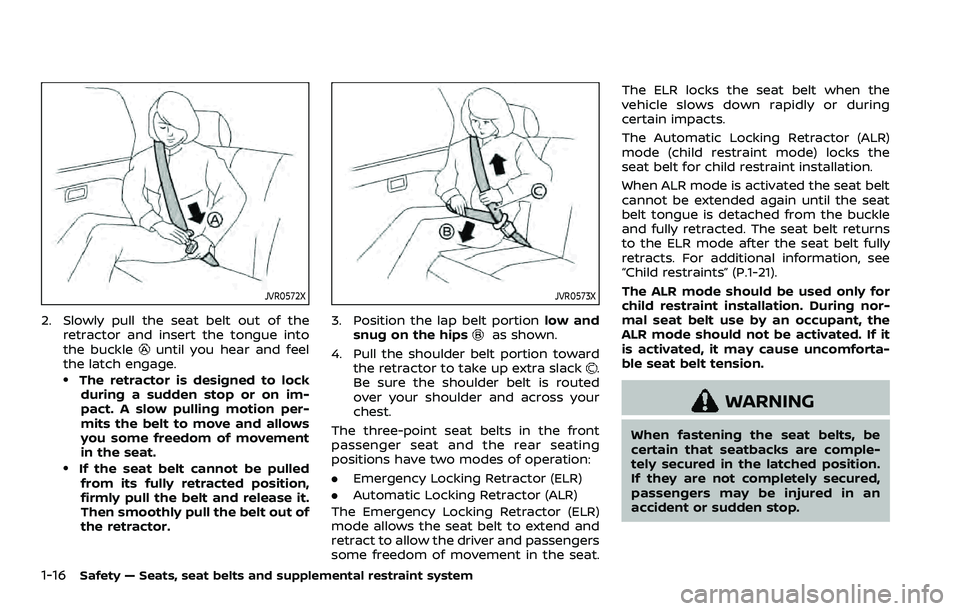
1-16Safety — Seats, seat belts and supplemental restraint system
JVR0572X
2. Slowly pull the seat belt out of theretractor and insert the tongue into
the buckle
until you hear and feel
the latch engage.
.The retractor is designed to lock
during a sudden stop or on im-
pact. A slow pulling motion per-
mits the belt to move and allows
you some freedom of movement
in the seat.
.If the seat belt cannot be pulledfrom its fully retracted position,
firmly pull the belt and release it.
Then smoothly pull the belt out of
the retractor.
JVR0573X
3. Position the lap belt portion low and
snug on the hipsas shown.
4. Pull the shoulder belt portion toward the retractor to take up extra slack
.
Be sure the shoulder belt is routed
over your shoulder and across your
chest.
The three-point seat belts in the front
passenger seat and the rear seating
positions have two modes of operation:
. Emergency Locking Retractor (ELR)
. Automatic Locking Retractor (ALR)
The Emergency Locking Retractor (ELR)
mode allows the seat belt to extend and
retract to allow the driver and passengers
some freedom of movement in the seat. The ELR locks the seat belt when the
vehicle slows down rapidly or during
certain impacts.
The Automatic Locking Retractor (ALR)
mode (child restraint mode) locks the
seat belt for child restraint installation.
When ALR mode is activated the seat belt
cannot be extended again until the seat
belt tongue is detached from the buckle
and fully retracted. The seat belt returns
to the ELR mode after the seat belt fully
retracts. For additional information, see
“Child restraints” (P.1-21).
The ALR mode should be used only for
child restraint installation. During nor-
mal seat belt use by an occupant, the
ALR mode should not be activated. If it
is activated, it may cause uncomforta-
ble seat belt tension.
WARNING
When fastening the seat belts, be
certain that seatbacks are comple-
tely secured in the latched position.
If they are not completely secured,
passengers may be injured in an
accident or sudden stop.
Page 60 of 508
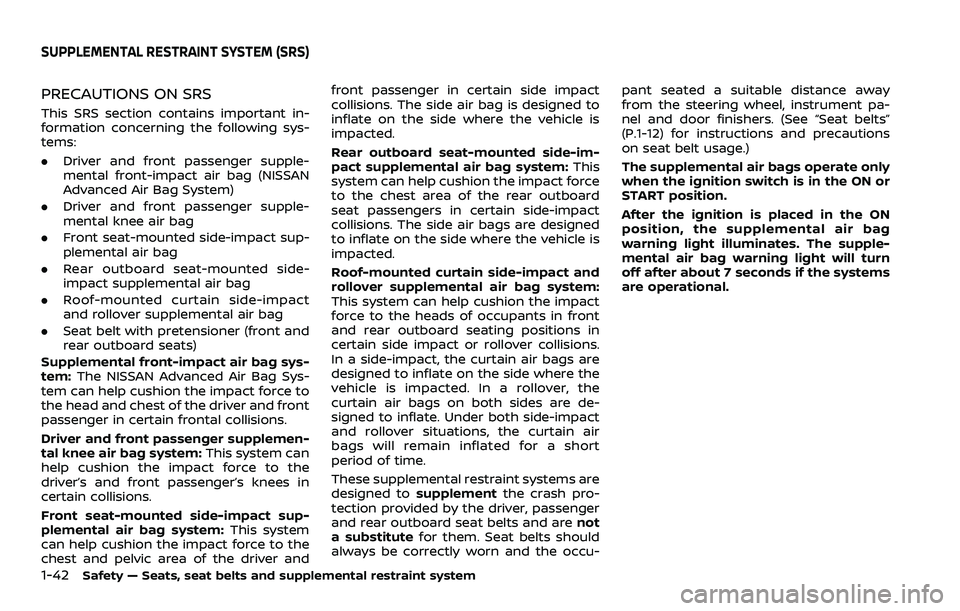
1-42Safety — Seats, seat belts and supplemental restraint system
PRECAUTIONS ON SRS
This SRS section contains important in-
formation concerning the following sys-
tems:
.Driver and front passenger supple-
mental front-impact air bag (NISSAN
Advanced Air Bag System)
. Driver and front passenger supple-
mental knee air bag
. Front seat-mounted side-impact sup-
plemental air bag
. Rear outboard seat-mounted side-
impact supplemental air bag
. Roof-mounted curtain side-impact
and rollover supplemental air bag
. Seat belt with pretensioner (front and
rear outboard seats)
Supplemental front-impact air bag sys-
tem: The NISSAN Advanced Air Bag Sys-
tem can help cushion the impact force to
the head and chest of the driver and front
passenger in certain frontal collisions.
Driver and front passenger supplemen-
tal knee air bag system: This system can
help cushion the impact force to the
driver’s and front passenger’s knees in
certain collisions.
Front seat-mounted side-impact sup-
plemental air bag system: This system
can help cushion the impact force to the
chest and pelvic area of the driver and front passenger in certain side impact
collisions. The side air bag is designed to
inflate on the side where the vehicle is
impacted.
Rear outboard seat-mounted side-im-
pact supplemental air bag system:
This
system can help cushion the impact force
to the chest area of the rear outboard
seat passengers in certain side-impact
collisions. The side air bags are designed
to inflate on the side where the vehicle is
impacted.
Roof-mounted curtain side-impact and
rollover supplemental air bag system:
This system can help cushion the impact
force to the heads of occupants in front
and rear outboard seating positions in
certain side impact or rollover collisions.
In a side-impact, the curtain air bags are
designed to inflate on the side where the
vehicle is impacted. In a rollover, the
curtain air bags on both sides are de-
signed to inflate. Under both side-impact
and rollover situations, the curtain air
bags will remain inflated for a short
period of time.
These supplemental restraint systems are
designed to supplement the crash pro-
tection provided by the driver, passenger
and rear outboard seat belts and are not
a substitute for them. Seat belts should
always be correctly worn and the occu- pant seated a suitable distance away
from the steering wheel, instrument pa-
nel and door finishers. (See “Seat belts”
(P.1-12) for instructions and precautions
on seat belt usage.)
The supplemental air bags operate only
when the ignition switch is in the ON or
START position.
After the ignition is placed in the ON
position, the supplemental air bag
warning light illuminates. The supple-
mental air bag warning light will turn
off after about 7 seconds if the systems
are operational.
SUPPLEMENTAL RESTRAINT SYSTEM (SRS)
Page 66 of 508
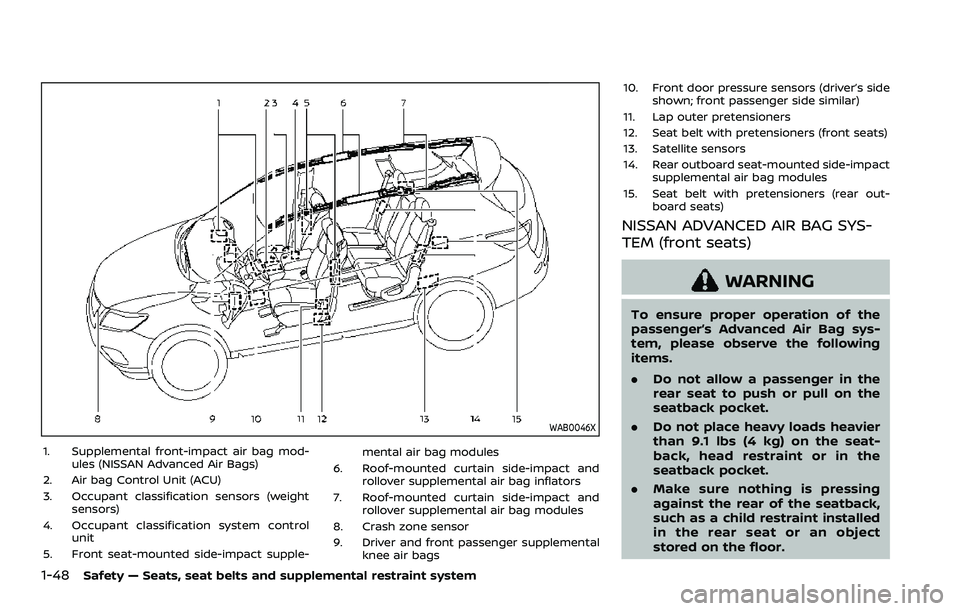
1-48Safety — Seats, seat belts and supplemental restraint system
WAB0046X
1. Supplemental front-impact air bag mod-ules (NISSAN Advanced Air Bags)
2. Air bag Control Unit (ACU)
3. Occupant classification sensors (weight sensors)
4. Occupant classification system control unit
5. Front seat-mounted side-impact supple- mental air bag modules
6. Roof-mounted curtain side-impact and rollover supplemental air bag inflators
7. Roof-mounted curtain side-impact and rollover supplemental air bag modules
8. Crash zone sensor
9. Driver and front passenger supplemental knee air bags 10. Front door pressure sensors (driver’s side
shown; front passenger side similar)
11. Lap outer pretensioners
12. Seat belt with pretensioners (front seats)
13. Satellite sensors
14. Rear outboard seat-mounted side-impact supplemental air bag modules
15. Seat belt with pretensioners (rear out- board seats)
NISSAN ADVANCED AIR BAG SYS-
TEM (front seats)
WARNING
To ensure proper operation of the
passenger’s Advanced Air Bag sys-
tem, please observe the following
items.
.Do not allow a passenger in the
rear seat to push or pull on the
seatback pocket.
. Do not place heavy loads heavier
than 9.1 lbs (4 kg) on the seat-
back, head restraint or in the
seatback pocket.
. Make sure nothing is pressing
against the rear of the seatback,
such as a child restraint installed
in the rear seat or an object
stored on the floor.
Page 76 of 508
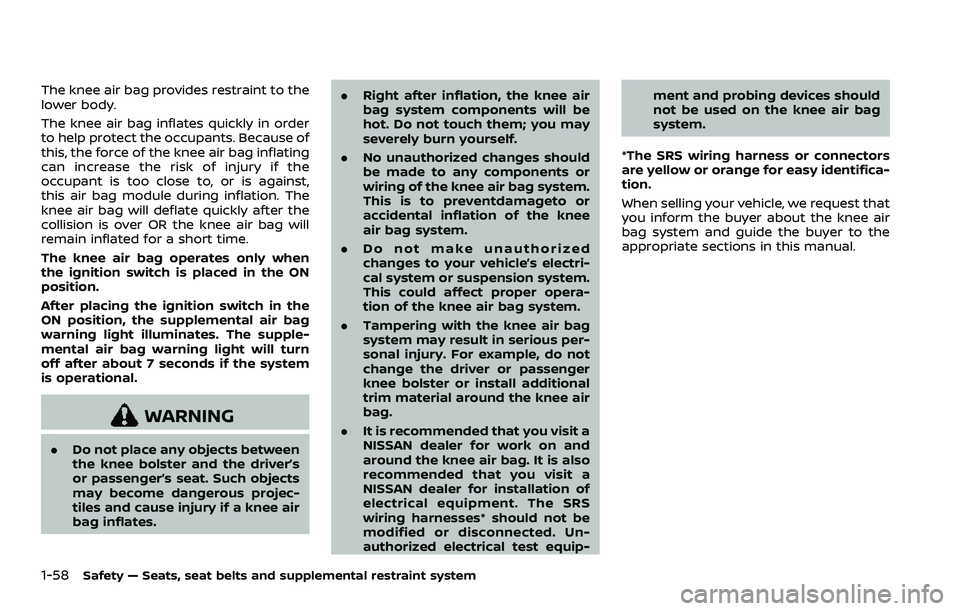
1-58Safety — Seats, seat belts and supplemental restraint system
The knee air bag provides restraint to the
lower body.
The knee air bag inflates quickly in order
to help protect the occupants. Because of
this, the force of the knee air bag inflating
can increase the risk of injury if the
occupant is too close to, or is against,
this air bag module during inflation. The
knee air bag will deflate quickly after the
collision is over OR the knee air bag will
remain inflated for a short time.
The knee air bag operates only when
the ignition switch is placed in the ON
position.
After placing the ignition switch in the
ON position, the supplemental air bag
warning light illuminates. The supple-
mental air bag warning light will turn
off after about 7 seconds if the system
is operational.
WARNING
.Do not place any objects between
the knee bolster and the driver’s
or passenger’s seat. Such objects
may become dangerous projec-
tiles and cause injury if a knee air
bag inflates. .
Right after inflation, the knee air
bag system components will be
hot. Do not touch them; you may
severely burn yourself.
. No unauthorized changes should
be made to any components or
wiring of the knee air bag system.
This is to preventdamageto or
accidental inflation of the knee
air bag system.
. Do not make unauthorized
changes to your vehicle’s electri-
cal system or suspension system.
This could affect proper opera-
tion of the knee air bag system.
. Tampering with the knee air bag
system may result in serious per-
sonal injury. For example, do not
change the driver or passenger
knee bolster or install additional
trim material around the knee air
bag.
. It is recommended that you visit a
NISSAN dealer for work on and
around the knee air bag. It is also
recommended that you visit a
NISSAN dealer for installation of
electrical equipment. The SRS
wiring harnesses* should not be
modified or disconnected. Un-
authorized electrical test equip- ment and probing devices should
not be used on the knee air bag
system.
*The SRS wiring harness or connectors
are yellow or orange for easy identifica-
tion.
When selling your vehicle, we request that
you inform the buyer about the knee air
bag system and guide the buyer to the
appropriate sections in this manual.